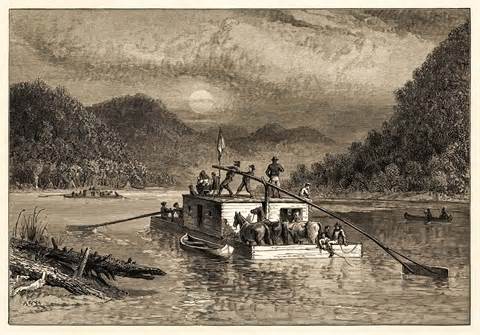Encyclopedia Dubuque
"Encyclopedia Dubuque is the online authority for all things Dubuque, written by the people who know the city best.”
Marshall Cohen—researcher and producer, CNN
Affiliated with the Local History Network of the State Historical Society of Iowa, and the Iowa Museum Association.
KEELBOATS
KEELBOATS. Once the primary means of carrying trade goods up river and cargoes down river, keelboats averaged sixty feet long, eighteen feet wide, with a five-foot cabin above the deck. The average cost of building one was $2,500. Keelboats had a sharp bow and stern. A swivel gun on the bow was used for protection. These boats were capable of carrying twenty tons of trade goods and were pulled, poled or rowed. (1)
A keelboat crew included a patron or captain, bosseman or assistant patron, and twenty voyageurs who pulled the boat up river by means of a 300-yard cordell rope attached to the upper portion of the boat's mast. The patron kept the boat in the channel as the bosseman shouted orders. A keelboat under ideal conditions could be pulled fifteen miles per day. (2) A variety of methods of moving the boat also included poling with "shoulder poles," which were shoved into the river bottom, and which the boatman pushed, walking from bow to stern. A hawser (rope) mounted to a reel on board could be attached to a tree or a stump on shore and wound in. Overhanging branches were used. They were grasped by the men from the deck, drawing the keelboat along in a method called "bushwhacking", and finally there was a mast and sail useful depending in any prevailing wind. (3)
For a time, keelboats were the regular packets of the rivers. They were not broken up at the end of the voyage and required trained crews for their navigation. Keelboatmen were the terror of the residents along the shores. A wild, turbulent group, they were ready to fight or dance. Drinkers, gamblers and self-professed 'half-alligator', 'half-horse', they were also partial to a sentimental song. (4)
This upriver trade was strenuous and very time-consuming which the early steamboats gradually took over as they ventured further up the river system. Keelboats continued to be used upriver on some tributaries where steamboats could not navigate as late as 1855. Keelboatmen turned to work on steamboats, FLATBOATS and rafts. Even though steamboats increased in number, there was still sufficient downstream trade for flatboats, which also increased, since traders now had an easy, faster way to return upriver. (5)
---
Source:
1. "River Transportation," National Park Service pamphlet.
2. Ibid.
3. "Fur Traders' Keelboat," Steamboat Times, Online: http://steamboattimes.com/keelboats.html
4. Ibid.
5. Ibid.



